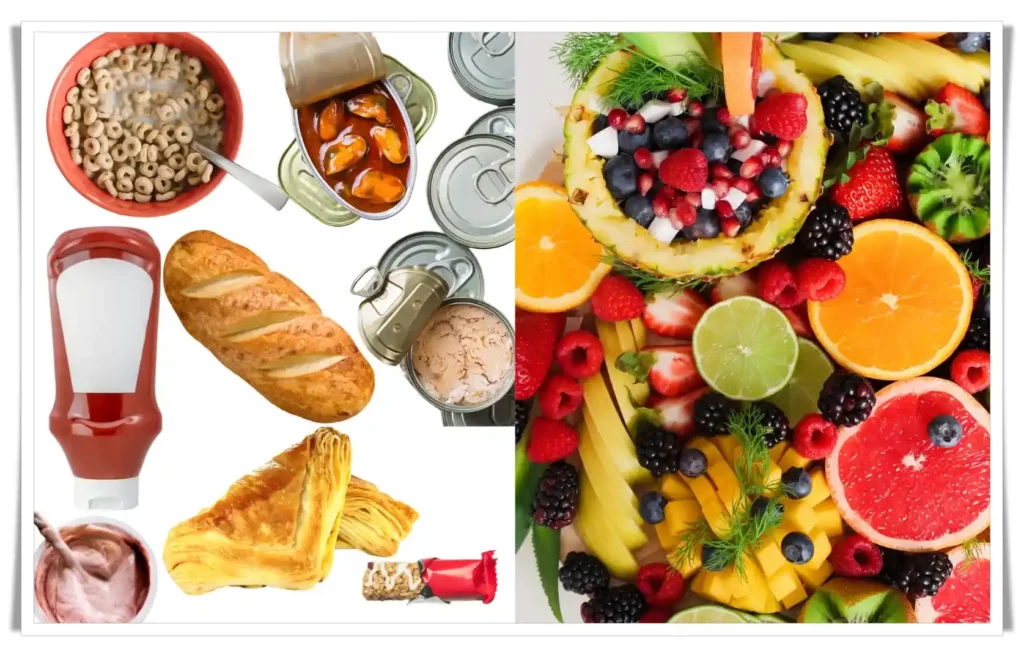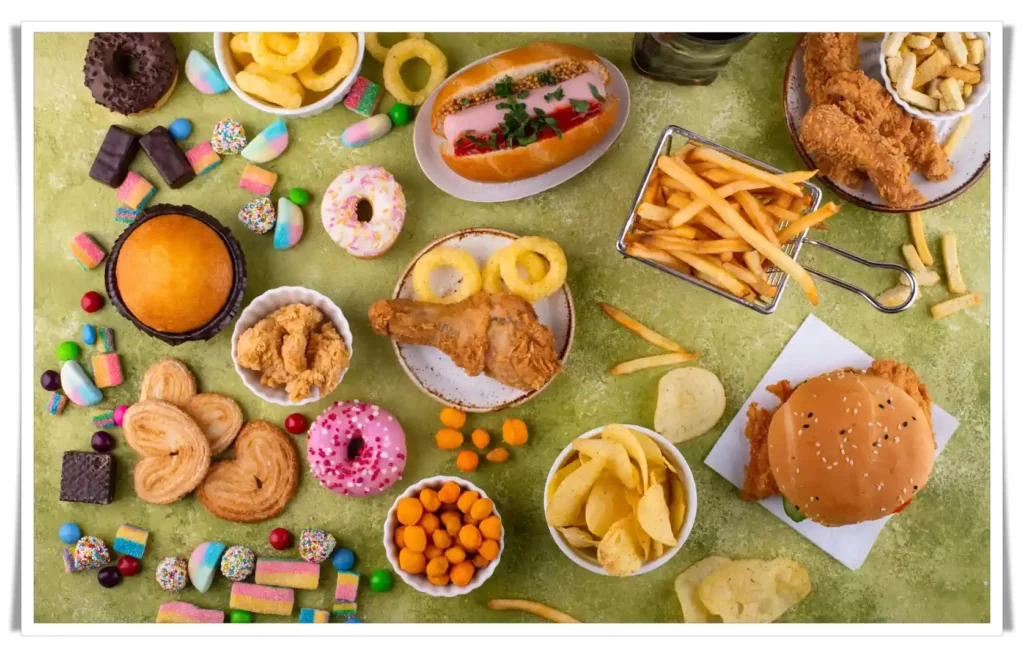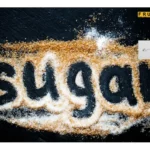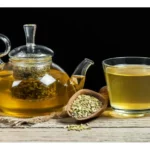Introduction: The Sweet Sabotage
Have you ever wondered how the sugars lurking in ultra-processed foods affect your well-being? From hidden sugars to high fructose corn syrup, these sweet culprits can silently wreak havoc on your health. In this article, we delve into the science behind these sugars and their intricate dance within our bodies. Brace yourself for a revealing journey into the world of processed sugars and their undeniable influence on your health.
Empower Your Health Journey – Explore My Free Apps for a Vibrant, Healthier Lifestyle Today!
From the first sip of our morning coffee to the last bite of our late-night dessert, sugar is a ubiquitous companion. But what if I told you that this sweet guest has overstayed its welcome in our diets? There's a sweet sabotage afoot, and it's more covert than you might think.
Each day, countless people consume products laced with added sugars, often hidden behind deceptive names and attractive packaging. These sugars have infiltrated our pantries, our refrigerators, and our daily meals, slowly impacting our health. From weight gain and dental cavities to more severe health concerns like diabetes and heart disease, the fallout of this sweet onslaught is vast and concerning.
As we stand on the precipice of a health crisis, it becomes imperative to pull back the sugary curtain and reveal the true nature of this pervasive ingredient. This journey will take us deep into the labyrinth of the food industry, nutrition science, and our very habits. Join me as we uncover the sweet sabotage and arm ourselves with knowledge to combat its effects.
Understanding the Sugar Conundrum
The world of sweet sabotage is vast and intricate. From natural sugars hidden within fruits to the artificial sweeteners lining our supermarket shelves, the spectrum of sugars is wide and often misleading. Before explore, it's essential to understand the players on the field.
Sugar, in its many forms, has been a cornerstone of our diets for centuries. Its sweet allure has made it a staple in our kitchens, an indispensable ingredient in our recipes, and, unfortunately, a silent assailant to our health. To navigate the maze of sugars and sweeteners populating our food landscape, we first need to understand the intricate conundrum that is sugar.
At its core, sugar isn't inherently evil. In nature, it's found in fruits, vegetables, and grains - all parts of a balanced diet. It's the energy source that fuels our cells and keeps our brains active. However, as with many things in life, the devil lies in the dose and the form.
Natural vs. Added Sugars
Sugar, at its essence, is a simple carbohydrate that our bodies use for energy. But not all sugars are created equal.
Natural Sugars: When we think of natural sugars, we often picture fruits, vegetables, and honey. These sugars are naturally occurring in the food sources. For example, fructose is the sugar found in fruits, and lactose is the sugar present in milk. When we consume foods with natural sugars, we aren't just getting sugar. These foods bring with them a plethora of other nutrients—vitamins, minerals, fibers, and antioxidants. For instance, while an apple does contain sugar, it also provides dietary fiber, vitamin C, and various beneficial compounds.

Added Sugars: On the flip side, there are added sugars, which, as the name suggests, are added to foods and beverages during their processing or preparation. These sugars, often sourced from sugarcane or beets, don't come with the nutritional accompaniments that natural sugars do. Instead, they pack pure, empty calories. Whether it's the sugar in your soda, the syrup in your latte, or the sweetener in your cereal, added sugars inundate our diets without contributing any substantial nutritional value. This inundation is the root of many health issues, including obesity, heart disease, and type 2 diabetes.
The Pervasive Presence of Added Sugars
The reach of added sugars is alarmingly extensive in our modern food ecosystem. While we might expect to find them in cakes, cookies, and candies, these sneaky sugars have made their way into seemingly unlikely places.
Ever wondered why that loaf of bread tastes just a tad sweet? Or why that savoury salad dressing leaves a slight sugary aftertaste? The answer: is added sugars. It's not just about enhancing flavour; manufacturers often use added sugars to improve texture, extend shelf life, or even mask other less palatable tastes in the food.
For instance, many processed foods contain acidic components, and sugar can help balance out those flavours. Moreover, sugar acts as a preservative, extending the shelf life of products like jams, jellies, and some sauces.
This widespread inclusion makes it a challenge for the average consumer to navigate their diet without a hefty dose of added sugars. It underscores the importance of reading labels and understanding where these sugars lurk, even in the most unexpected places.
The Ultra-Processed Predicament
In today's fast-paced world, convenience often takes precedence over quality. The food industry has responded to this demand with an arsenal of ultra-processed foods — ready-to-eat products that require minimal preparation and promise maximum flavor. But what might seem like a solution to our hectic lifestyles is, in reality, a primary battlefield in the sweet sabotage we're discussing.
Ultra-processed foods, with their long shelf lives and addictive taste profiles, often owe their allure to a concoction of additives, preservatives, and notably, added sugars. But here's the kicker: these sugars aren't just present in the obvious sweet-tasting products. They've permeated almost every corner of the processed food market.
Common Sources of Hidden Sugars
While sodas and candies are the usual suspects when it comes to high sugar content, the scope of added sugars extends far beyond these. Let's unpack some less obvious culprits.

Breakfast Cereals: Marketed as a healthy start to your day, many cereals are laden with sugars. Even those labeled "whole grain" or "fiber-rich" can be misleading, masking high sugar content behind a facade of health claims.
Flavored Yogurts: Yogurt, in its natural state, is a nutritious food. However, once it's flavored and commercialized, its sugar content can skyrocket. Some flavored yogurts contain sugar levels equivalent to that of a dessert.
'Health' Bars: Energy bars, protein bars, or granola bars — often perceived as nutritious snacks — can sometimes be just glorified candy bars. With syrups, honey, and other sweeteners, some of these bars can pack a sugary punch that belies their "healthy" branding.
Sauces and Dressings: Tomato ketchup, BBQ sauce, and even some salad dressings can contain startling amounts of sugar. They might add flavor to our meals, but they also sneak in unwanted sugars.
Canned and Packaged Foods: From canned fruits bathed in syrup to ready-to-eat soups, many packaged foods contain added sugars to enhance taste and increase preservation.
The Health Impact Unveiled
Sugar, often considered a simple indulgence, hides a complex narrative when it comes to our health. Its impact isn't limited to just that fleeting energy rush followed by a crash. The consequences of consuming added sugars span across various systems in our body, influencing our well-being on multiple fronts.
Sugar and Metabolic Disorders
Metabolism is our body's way of converting what we eat into energy. However, like any finely tuned machine, it requires balance. Excessive sugar consumption can throw this balance into disarray, leading to a series of metabolic disturbances.
For example, frequent high sugar intake can make our cells resistant to insulin, a hormone essential for glucose uptake. This resistance is a precursor to Type 2 diabetes, a chronic condition affecting millions worldwide. Additionally, a diet rich in fructose, a type of sugar, has been implicated in non-alcoholic fatty liver disease. In this condition, fat accumulates in liver cells, impairing its function and potentially leading to liver damage over time.
Sugar's Role in Weight Gain and Obesity
It's a simple equation: more calories in than out leads to weight gain. But when these extra calories predominantly come from added sugars, the issue becomes twofold.
Firstly, sugars are energy-dense. This means even a small volume can pack a large number of calories. So, when we frequently indulge in sugary treats or drinks, those calories accumulate rapidly. Over time, this surplus can manifest as significant weight gain.

Secondly, foods high in added sugars often lack essential nutrients. They fill us up without providing our bodies with the vitamins, minerals, and other compounds we need. This can lead to overeating, as our bodies seek out the nutrients they're missing, further contributing to weight gain and elevating the risk of obesity.
Dental Dilemmas: Sugar and Oral Health
A smile can say a lot, but added sugars might be compromising the health behind that smile. Our mouths are home to diverse bacteria. While many are harmless, some can be detrimental to our dental health, especially when they feed on the sugars we consume.
These bacteria produce acids as they digest these sugars. This acid can erode our tooth enamel, the protective outer layer of our teeth, leading to cavities. Over time, consistent exposure to these acids, combined with poor dental hygiene, can lead to more severe dental issues like gum disease and tooth loss.
Moreover, sugary foods and drinks often stick to our teeth, providing a continuous food source for harmful bacteria. This only accentuates their negative effects on our oral health, emphasizing the importance of moderation and diligent dental care.
A Closer Look at Different Types of Added Sugars
From high fructose corn syrup to agave nectar, the variety of added sugars is vast. It's crucial to recognize and understand each.
A List With The Composition and Typical Uses of Each Of The Added Sugars

- Agave nectar/syrup: Derived from the agave plant, it's sweeter than honey and is often used in vegan diets as a honey substitute. Found in various beverages, baked goods, and health foods.
- Barley malt: Made from sprouted barley and is used as a sweetener and flavour enhancer. Found in cereals and malt beverages.
- Barley malt syrup: A sweet syrup made from malted barley. Used in bread and health foods.
- Beet sugar: Sugar derived from sugar beets. Used almost interchangeably with cane sugar in many processed foods.
- Brown rice syrup: Made from brown rice. Often used in organic and health foods.
- Brown sugar: Made from sugar crystals with some residual molasses. Common in baking and cooking.
- Cane juice: The liquid extracted from sugar cane. Used in beverages and some processed foods.
- Cane juice crystals: Dehydrated and crystallized cane juice. Used in sweetening beverages and baking.
- Cane sugar: Refined sugar from sugar cane. Ubiquitous in processed foods.
- Caramel: Burnt sugar, used for coloring and flavoring. Found in soft drinks, confections, and baked goods.
- Carob syrup: Extracted from carob pods. Used as a sweetener in some health foods.
- Castor sugar: Finely granulated white sugar. Used in baking for its easily dissolvable nature.
- Coconut sugar or coconut palm sugar: Made from the sap of coconut palms. Often found in health foods.
- Confectioner's sugar (powdered sugar): Very finely ground sugar with added anti-caking agents. Used in icing and pastries.
- Corn sweetener: General term for sweeteners derived from corn. Used in a variety of processed foods.
- Corn syrup: Derived from cornstarch, less sweet than sucrose. Found in candies, jams, and baked goods.
- Corn syrup solids: Dehydrated corn syrup. Used in various processed foods.
- Date sugar: Made from dried dates. Used in health foods and some baked goods.
- Dehydrated cane juice: Another term for granulated sugar. Found in many processed foods.
- Dextrin: Not particularly sweet; it's a by-product of starch hydrolysis. Used in processed foods for texture.
- Dextrose: A simple sugar derived from corn. Used in baking and also in medical applications.
- Diastatic malt: Made from barley, it has active enzymes that break down starch into sugar. Used in bread making.
- Ethyl maltol: A flavor enhancer with a sweet odor. Found in e-liquids and some candies.
- Evaporated cane juice: Less refined sugar with minimal molasses. Used in beverages and health foods.
- Florida crystals: A brand of organic cane sugar.
- Fructose: A natural sugar found in many fruits. Used in beverages, candies, and baked goods when processed.
- Fruit juice: Used as a sweetener when sugar needs to be labeled as "natural". Found in many beverages.
- Fruit juice concentrate: Concentrated sugars from fruit juices. Used in beverages, confections, and health foods.
- Glucose: A simple sugar. Used in candies, baked goods, and medical applications.
- Glucose solids: Dehydrated glucose. Used in processed foods.
- Golden sugar: Light brown sugar. Used in baking.
- Golden syrup: Refined sugar syrup. Used in baking, especially British desserts.
- Grape sugar: Another term for glucose, sometimes derived from grapes.
- High fructose corn syrup (HFCS): A processed form of corn syrup with higher fructose content. Ubiquitous in sodas, candies, and many processed foods.
- Honey: Natural sweetener made by bees. Used in many foods and beverages.
- Icing sugar: Another term for confectioner's or powdered sugar.
- Invert sugar: Split sucrose into glucose and fructose. Used in candies and baked goods for moisture retention.
- Lactose: Sugar from milk. Less sweet, and used in some processed foods.
- Malt syrup: Syrup made from malted grains. Used in baking and candies.
- Maltodextrin: Derived from starch, less sweet. Used as a filler and texture agent in many foods.
- Maltose: Sugar produced from malted grains. Found in some beverages and foods.
- Maple syrup: Made from the sap of sugar maple trees. Used as a sweetener in various dishes.
- Molasses: Thick by-product syrup of sugar refining. Used in baking and confections.
- Muscovado sugar: Less refined brown sugar with strong molasses flavor. Used in baking.
- Palm sugar: Made from the sap of sugar palm trees. Used in Asian cooking.
- Panocha or piloncillo: Unrefined cane sugar. Used in Hispanic cooking.
- Raw sugar: Less refined sugar with some molasses. Often used as a sweetener in beverages.
- Refiner's syrup: A by-product of sugar refining. Used in some processed foods.
- Rice bran syrup: Made from the bran of rice. Used in health foods.
- Rice syrup: Derived from rice. Used in health foods and some processed foods.
- Saccharose: Scientific name for sucrose.
- Sorghum syrup: Made from sweet sorghum. Used in some Southern U.S. cooking.
- Sucrose: Common table sugar, derived from sugar cane or beets.
- Sugar: Usually refers to sucrose.
- Sugar beet syrup: Made from sugar beets. Used in some European foods.
- Sugar crystals: Larger crystals of refined sugar. Used as a topping or for decorative purposes.
- Syrup: General term for a thick liquid sweetener.
- Treacle: British term for molasses.
- Trehalose: Double glucose sugar. Found in mushrooms and used in some processed foods for its moisture retention properties.
- Turbinado sugar: Partially refined sugar with some molasses. Used in beverages and baking.
- Yellow sugar: Another term for light brown sugar.
Added Sugar Risk - With Evidence!
While excess consumption of any added sugar can lead to health problems, some have been associated with specific concerns. Here are some of the sugars that have raised health concerns:
- High Fructose Corn Syrup (HFCS): Several studies have suggested that the consumption of HFCS may be linked to obesity, fatty liver disease, and other metabolic disorders.
- Evidence: Research from Princeton University
- Agave Nectar: Initially marketed as a healthful alternative to other sweeteners, concerns have risen due to its high fructose content, which can impact liver function and insulin sensitivity.
- Evidence: Medical News Today
- Artificial Sweeteners (e.g., Aspartame, Saccharin, Sucralose): Although approved for consumption by food safety authorities, some studies suggest potential links to headaches, digestive problems, and possibly even cancer. It's essential to understand that the evidence isn't conclusive, and findings often depend on the population studied and doses administered.
- Evidence: Harvard Health on Artificial Sweeteners
- Evidence (Aspartame- Cancer Risk): World Health Organizations
- Sugar Alcohols (e.g., Xylitol, Sorbitol, Mannitol): Generally considered safe in small amounts, excessive consumption can lead to digestive issues like bloating, gas, heart disease, and diarrhoea.
- Evidence: Cleveland Clinic on sugar alcohols
- Sucrose: Regular table sugar, when consumed excessively, has been linked to various health issues, including obesity, type 2 diabetes, heart disease, and dental cavities.
- Fructose: While fructose naturally occurs in fruits, when isolated and consumed in large amounts (like in sweetened beverages), it bypasses usual metabolic pathways and goes straight to the liver, possibly leading to non-alcoholic fatty liver disease and other metabolic disturbances.
- Caramel Color: While not a sweetener per se, it's a common ingredient in colas and some other sweetened beverages. Some types of caramel color may contain contaminants like 4-methylimidazole (4-MEI), a potential carcinogen.
- Evidence: Consumer Reports on caramel color
- Acesulfame Potassium (Ace-K): An artificial sweetener often found in sugar-free products. While approved for use, some animal studies have raised concerns about its safety.
- Evidence: Research Gate on Acesulfame Potassium
- Steviol Glycosides (Stevia): Derived from the leaves of the Stevia plant, they're a popular "natural" sweetener. Some people might experience gastrointestinal discomfort or allergic reactions. There are also studies on its impact on blood pressure and blood sugar, though it's generally considered safe when consumed within recommended limits.
- Evidence: PubMed on Steviol Glycosides
- Maltodextrin: While it's derived from natural starches, its high glycemic index means it can cause rapid spikes in blood sugar. This can be a concern for individuals with diabetes or those at risk.
- BHA and BHT: These are not sweeteners, but they're often used as preservatives in sugary cereals and other processed foods. Some studies indicate they might be carcinogenic.
- Galactose: Found naturally in milk and dairy, galactose has been linked in some studies to oxidative stress and inflammation when isolated and consumed in excess. However, the typical dietary amounts in dairy are usually not a concern for most individuals.
- Evidence: PubMed on Galactose and aging
How to Identify Hidden Sugars
In our quest for a healthier lifestyle, one of the primary challenges we face is the sneaky nature of added sugars in our food products. They often masquerade under exotic or scientific-sounding names, making it difficult for the average consumer to identify them. But understanding these covert names is the first step in reclaiming control over our diets.

For instance, terms like "maltodextrin" might sound unrelated to sugar, but they are derived from starchy foods and act as sweeteners in many products. Similarly, "fructose" might be associated with fruits, but when isolated and used as an ingredient, it's just another added sugar. And don't be fooled by the term "organic cane juice." Despite its health-conscious sounding name, it's still sugar derived from sugarcane.
To successfully navigate this landscape, it's crucial to familiarize oneself with these alternative sugar names. Checking ingredient lists vigilantly and being aware of potential sugar sources can significantly help in reducing unintentional sugar consumption.
The Sugar-Content Trap: Marketing Tactics
The realm of marketing is filled with tactics designed to attract consumers and promote a product's perceived value. The food industry, especially the segments dealing with sugary products, is no exception.
Phrases like "lightly sweetened" might sound healthier, implying a reduced sugar content. However, "lightly" is a relative term and may still mean a significant amount of sugar. Similarly, "natural sweetness" can be misleading. While it suggests the product derives its sweetness from natural sources, it doesn't specify the amount or type, leaving room for high levels of natural sugars or sweeteners.
These marketing tactics aren't just limited to product labels. Advertisements showcasing active lifestyles, fit individuals, or emphasizing the "natural" aspect of a product can create a health halo around sugary products, leading consumers to believe they're making a healthier choice.
Being an informed consumer involves looking beyond these marketing tactics. It's essential to read nutritional labels, understand serving sizes, and know the various names under which sugar might be lurking in your favorite products. By doing so, we can make choices that align better with our health goals and are not solely influenced by crafty advertising.
Frequently Asked Questions (FAQs):
H2: What Are Added Sugars? Added sugars are sweeteners added to foods and drinks during processing or preparation.
H3: How Do They Differ from Natural Sugars? Natural sugars occur naturally in foods, while added sugars are incorporated during processing.
H2: Which Ultra-Processed Foods Are Particularly High in Added Sugars? Sodas, candies, baked goods, and many breakfast cereals are notorious for their high added sugar content.
H3: Can You Provide Examples of Sneaky Sugar Names? Certainly! Fructose, maltose, and dextrose are just a few.
H2: What Are the Immediate Effects of Consuming Excessive Sugars? Rapid blood sugar spikes, followed by crashes, leading to fatigue and further cravings.
H3: How Does Sugar Impact Blood Sugar Levels? Excess sugar causes rapid blood sugar spikes, putting stress on insulin production and function.
H2: How Can I Identify and Avoid Hidden Sugars in my Diet? By reading food labels diligently and understanding different names for sugars.
H3: Are There Reliable Resources for Sugar-Free Recipes? Absolutely! Many websites and cookbooks offer sugar-free or low-sugar recipes. Consider checking out "Sugar and fructose, Our friends or Our Enemies" for insights.
H2: What Are Some Practical Tips for Reducing Sugar Consumption in Everyday Life? Opt for unsweetened beverages, read food labels, and cook at home more often to control ingredients.
H3: How Can I Satisfy Sweet Cravings in a Healthier Way? Consider natural sweeteners like fruits or limited amounts of honey and maple syrup.
Conclusion: Improve Your Health Journey
Understanding the sweet sabotage is the first step to reclaiming control over your health. With the knowledge you've gained today, you're better equipped to make informed decisions. Don't forget to watch my YouTube video, “The Top 25 Foods with Shockingly High Levels of Hidden Sugar” for more insights. Remember, a lifeless sweet can be far richer in health and happiness. Research more, stay informed, and embark on a sugar-conscious journey towards better health.
Call to Action: Have any insights or personal experiences with sugar's impact on health? Share your stories in the comments below. We'd love to hear from you!
Table of Relevant Studies and Sources:
| Title & Link | Brief Description |
|---|---|
| Harvard Health on Sugar Intake | The cardiovascular risks of excessive sugar consumption. |
| WHO Guidelines on Sugar | WHO's recommendations on daily sugar intake. |





I’m lost in the ocean of knowledge on your website, and I hope that your intellectual journey continues to go well. I hope you keep making waves.
naturally like your web site however you need to take a look at the spelling on several of your posts. A number of them are rife with spelling problems and I find it very bothersome to tell the truth on the other hand I will surely come again again.
I like the efforts you have put in this, regards for all the great content.
This is really interesting, You’re a very skilled blogger. I’ve joined your feed and look forward to seeking more of your magnificent post. Also, I’ve shared your site in my social networks!
Wonderful web site Lots of useful info here Im sending it to a few friends ans additionally sharing in delicious And obviously thanks to your effort
Hi my family member I want to say that this post is awesome nice written and come with approximately all significant infos I would like to peer extra posts like this
Thank you! Appreciate this.
Nice post. I learn something totally new and challenging on websites
Thank you for the auspicious writeup It in fact was a amusement account it Look advanced to far added agreeable from you However how can we communicate
Thank you for the fortunate post. It was rather entertaining. I look forward to more from you. How can we get in touch with you?
Hi Neat post Theres an issue together with your web site in internet explorer may test this IE still is the marketplace chief and a good component of people will pass over your fantastic writing due to this problem
Thank you for the fortunate post. It was rather entertaining. I look forward to more from you. How can we get in touch with you?
Thanks I have just been looking for information about this subject for a long time and yours is the best Ive discovered till now However what in regards to the bottom line Are you certain in regards to the supply
you are in reality a good webmaster The website loading velocity is amazing It sort of feels that youre doing any distinctive trick Also The contents are masterwork you have done a fantastic job in this topic
I was recommended this website by my cousin I am not sure whether this post is written by him as nobody else know such detailed about my difficulty You are wonderful Thanks
It was great seeing how much work you put into it. Even though the design is nice and the writing is stylish, you seem to be having trouble with it. I think you should really try sending the next article. I’ll definitely be back for more of the same if you protect this hike.
It was great seeing how much work you put into it. Even though the design is nice and the writing is stylish, you seem to be having trouble with it. I think you should really try sending the next article. I’ll definitely be back for more of the same if you protect this hike.
I loved even more than you will get done right here. The overall look is nice, and the writing is stylish, but there’s something off about the way you write that makes me think that you should be careful what you say next. I will definitely be back again and again if you protect this hike.
This is a really good place to read, and I’ve bookmarked it for later. I’m curious how much effort goes into making a webpage this excellent and instructive.
I’ve been browsing the internet for more than three hours, and I haven’t seen any posts as fascinating as yours. I think it’s well worth the investment. If more bloggers and website owners created content as good as you do, the internet would be significantly more useful than it already is.
I don’t usually read blog postings, but after reading this one, I had no choice but to try. Your writing style astounded me greatly. I appreciate your wonderful post.
Wow, incredible blog layout! How lengthy have you ever been running a blog for?
you made blogging look easy. The entire look of your website is magnificent, as smartly as
the content! You can see similar: sklep online and here e-commerce
hey there and thank you for your info – I have certainly picked up anything new from right here.
I did however expertise a few technical points using this
site, as I experienced to reload the website
many times previous to I could get it to load properly.
I had been wondering if your web hosting is
OK? Not that I am complaining, but sluggish loading instances
times will sometimes affect your placement in google and can damage your
high quality score if advertising and marketing with Adwords.
Anyway I am adding this RSS to my email and could look out for a lot more of your respective exciting
content. Make sure you update this again soon. I saw
similar here: najlepszy sklep and also here: e-commerce
bookmarked!!, I really like your blog! I saw similar here: Dobry sklep
Heya i am for the first time here. I came across this board and I find It
truly useful & it helped me out much. I hope to give something back and help others like
you aided me. I saw similar here: Sklep online